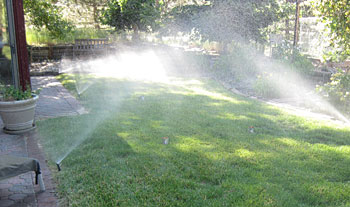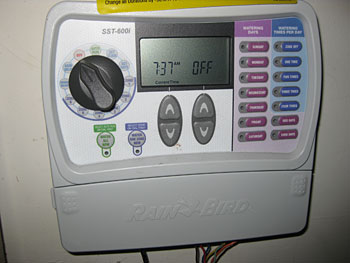Follow these tips to conserve water, crowd out weeds, and grow a thick, green lawn.
- Mow high. Set your mower on the highest setting, or about 3 inches, to encourage deep roots, shade out weeds and retain soil moisture. Never scalp your lawn by mowing too low, or you'll get brown spots.
- Remove no more than one-third of the grass blade when you mow. Grass blades make food for the grass roots.
- Start the season with sharp mower blades. Re-sharpen mower blades as needed during the growing season to provide clean cuts and prevent tearing of grass blades.
- Core aerate your lawn in the spring to relieve soil compaction and reduce thatch. After aerating, add a thin layer of compost (no more than one-quarter inch) and water it in. This feeds the soil.
- Use a mulching mower to recycle grass clippings back to your lawn. This adds nutrients and organic matter and reduces the amount of fertilizer needed to keep your lawn green.
- Fertilize no more than three times a year, and never in the heat of summer. If you only fertilize once a year, do it in the fall.
- Water early in the day or in the evening, when temperatures are lower and the wind is calm. Follow assigned-day watering if required by your community. Focus on deep watering to promote deep roots. Use cycles of watering so the water soaks into the ground and doesn't run off.
- Do a can test to tell if your irrigation system delivers water evenly. See http://www.unce.unr.edu/news/article.asp?ID=1378 for instructions. Adjust your system as needed to provide even water distribution.

Can tests are a good way to learn if your irrigation system is watering evenly.
- Adjust your irrigation system to change the amount of water as needed depending on weather and the season. In the spring when temperatures are mild (60s and 70s), watering once a week is often enough. As temperatures rise, adjust the amount of water you apply to replace just the amount of water used by the lawn. See www.washoeet.dri.edu for help.

Irrigation controllers are becoming easier to use all the time. After turning on the system in the spring, be sure to reprogram yours on a regular basis as your lawn's water needs change.
- Don't water when it's windy or during the heat of day, when evaporation is high.
- Fix irrigation system leaks and broken heads promptly.
Hefner, M.
2019,
Tips for a Healthy Lawn,
Extension | University of Nevada, Reno. IP


